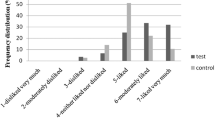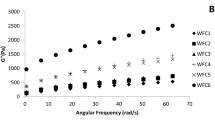Abstract
Carob flour is a product rich in fibre obtained from by-products of the locust bean gum extraction processing. The flour is commercialised with different degrees of roasting in order to improve its organoleptic characteristics. In this study, carob flour with three different roasting degrees was used to replace rice flour (15%) in gluten-free cakes and cookies. The influence of this replacement was studied on the psychochemical characteristics and acceptability of the final products. The incorporation of carob flour increased the viscosity of cake batters and increased the solid elastic-like behaviour of the cookie doughs, indicating a stronger interaction among the formula ingredients. The inclusion of carob flour, with a low time of roasting, did not lead to any significant differences in the specific volume and hardness of the cakes, but reduced cake staling and the thickness and width of the cookies. Darker colours were obtained when carob flour was incorporated into the product. The acceptability of cakes was only reduced with the addition of highly roasted carob flour, while in the case of cookies there was a decline in the acceptability of all carob flour cookies, which was mostly perceived with the highest roasting degree, something mainly attributed to the bitter taste of the products.

Similar content being viewed by others
References
AACC International (2012) Approved methods of the American Association of Cereal Chemists International. American Association of Cereal Chemists, St Paul
Ayaz FA, Torun H, Glew RH, Bak ZD, Chuang LT, Presley JM, Andrews R (2009) Nutrient content of carob pod (Ceratonia siliqua L.) flour prepared commercially and domestically. Plant Food Hum Nutr 64:286–292
Barak S, Mudgil D, Khatkar BS (2014) Effect of flour particle size and damaged starch on the quality of cookies. J Food Sci Technol 5:1342–1348
Barrera GN, Perez GT, Ribotta PD, Leon AE (2007) Influence of damaged starch on cookie and bread-making quality. Eur Food Res Technol 225:1–7
Cantalejo MJ (1997) Effects of roasting temperature on the aroma components of carob (Ceratonia siliqua L.). J Agric Food Chem 45:1345–1350
Cepo DV, Mornar A, Nigovic B, Kremer D, Radanovic D, Dragojevic IV (2014) Optimization of roasting conditions as an useful approach for increasing antioxidant activity of carob powder. LWT—Food Sci Technol 58:578–586
Dakia PA, Wathelet B, Paquot M (2007) Isolation and chemical evaluation of carob (Ceratonia siliqua L.) seed germ. Food Chem 102:1368–1374
Durazzo A, Turfani V, Narducci V, Azzini E, Maiani G, Carcea M (2014) Nutritional characterisation and bioactive components of commercial carobs flours. Food Chem 153:109–113
Fadel HHM, Mageed MAA, Samad AKMEA, Lotfy SN (2006) Cocoa substitute: evaluation of sensory qualities and flavour stability. Eur Food Res Technol 223:125–131
Gómez M, Ronda F, Caballero P, Blanco C, Rosell CM (2007) Functionality of different hydrocolloids on the quality and shelf-life of yellow layer cakes. Food Hydrocoll 21:167–173
Gómez M, Ruiz-Paris E, Oliete B, Pando V (2010) Modelling of texture evolution of cakes during storage. J Texture Stud 41:17–33
Haber B (2002) Carob fiber benefits and applications. Cereal Food World 47:365–369
Kumazawa S, Taniguchi M, Suzuki Y, Shimura M, Kwon MS, Nakayama TJ (2002) Antioxidant activity of polyphenols in carob pods. J Agric Food Chem 50:373–377
Laguna L, Sanz T, Sahi S, Fiszman SM (2014) Role of fibre morphology in some quality features of fibre-enriched biscuits. Int J Food Prop 17:163–178
Loeb H, Vandenplas Y, Wursch P, Guesry P (1989) Tannin-rich carob pod for the treatment of acute-onset diarrhea. J Pediatr Gastroenterol Nutr 8:480–485
Martínez MM, Pico J, Gómez M (2015) Effect of different polyols on wheat and maize starches paste and gel properties. Food Hydrocoll 44:81–85
Mildner-Szkudlarz S, Bajerska J, Zawirska-Wojtasiak R, Gorecka D (2013) White grape pomace as a source of dietary fibre and polyphenols and its effect on physical and nutraceutical characteristics of wheat biscuits. J Sci Food Agric 93:389–395
Miller RA, Hoseney RC (1997) Factors in hard wheat flour responsible for reduced cookie spread. Cereal Chem 74:330–336
Pareyt B, Decour JA (2008) The role of wheat flour constituents, sugar, and fat in low moisture cereal based products: a review on sugar-snap cookies. Crit Rev Food Sci Nutr 48:824–839
Pico J, Bernal J, Gómez M (2015) Wheat bread aroma compounds in crumb and crust: a review. Food Res Int 75:200–215
Purlis E (2010) Browning development in bakery products—a review. J Food Eng 99:239–249
Román L, Santos I, Martínez MM, Gómez M (2015) Effect of extruded wheat flour as a fat replacer on batter characteristics and cake quality. J Food Sci Technol 52:8188–8195
Ruiz-Roso B, Quintela JC, de la Fuente E, Haya J, Perez-Olleros L (2010) Insoluble carob fiber rich in polyphenols lowers total and LDL cholesterol in hypercholesterolemic sujects. Plant Food Hum Nutr 65:50–56
Rupasinghe HPV, Wang L, Huber GM, Pitts NL (2008) Effect of baking on dietary fibre and phenolics of muffins incorporated with apple skin powder. Food Chem 107:1217–1224
Sahin H, Topuz A, Pischetsrieder M, Ozdemir F (2009) Effect of roasting process on phenolic, antioxidant and browning properties of carob flour. Eur Food Res Technol 230:155–161
Sangeetha AV, Mahadevamma S, Begum K, Sudha ML (2011) Influence of processed sugarcane bagasse on the microbial, nutritional, rheological and quality characteristics of biscuits. Int J Food Sci Nutr 62:457–464
Seczyk L, Swieca M, Gawlik-Dziki U (2016) Effect of carob (Ceratonia siliqua L.) flour on the antioxidant potential, nutritional quality, and sensory characteristics of fortified durum wheat pasta. Food Chem 194:637–642
Stauffer CE (1990) Functional additives for bakery foods. Van Nostrand Reinhold, New York
Sudha ML, Baskaran V, Leelavathi K (2007) Apple pomace as a source of dietary fiber and polyphenols and its effect on the rheological characteristics and cake making. Food Chem 104:686–692
Tetik N, Turhan I, Oziyci HR, Karhan M (2011) Determination of D-pinitol in carob syrup. Int J Food Sci Nutr 62:572–576
Tsatsaragkou K, Yiannopoulos S, Kontogiorgi A, Poulli E, Krokida M, Mandala I (2014) Effect of carob flour addition on the rheological properties of gluten-free breads. Food Bioprocess Technol 7:868–876
USDA (2015) USDA National Nutrient Database for Standard Reference, Release 28. Version Current: September 2015. Internet: http://www.ars.usda.gov/ba/bhnrc/ndl. Accessed 26 March 2016
Valero-Muñoz M, Martin-Fernandez B, Ballesteros S, Lahera V, de las Heras N (2014) Carob pod insoluble fiber exerts anti-atherosclerotic effects in rabbits through sirtuin-1 and peroxisome proliferator-activated receptor-gamma coactivator-1 alpha. J Nutr 144:1378–1384
Vujic L, Cepo DV, Sebecic B, Dragojevic IV (2014) Effects of pseudocereals, legumes and inulin addition on selected nutritional properties and glycemic index of whole grain wheat-based biscuits. J Food Nutr Res 53:152–161
Yousif AK, Alghzawi HM (2000) Processing and characterization of carob powder. Food Chem 69:283–287
Zhou W, Therdthai N (2008) Heat and mass transfer during baking of sweet goods. In: Sumnu SG, Sahin S (eds) Food engineering aspects of baking sweet goods. CRC, Boca Raton, pp 173–190
Zunft HJF, Luder W, Harde A, Haber B, Graubaum HJ, Koebnick C, Grunwald J (2003) Carob pulp preparation rich in insoluble fibre lowers total and LDL cholesterol in hypercholesterolemic patients. Eur J Nutr 42:235–242
Acknowledgements
The authors acknowledge the financial support of the Spanish Ministry of Economy and Competitiveness (Project AGL2014-52928-C2) and the European Regional Development Fund (FEDER). The authors are also grateful to Harinera Castellana and G.A. Torres for supplying the raw materials. They also would like to thank Montserrat Prieto for her assistance whilst carrying out product analyses.
Author information
Authors and Affiliations
Corresponding author
Electronic supplementary material
Below is the link to the electronic supplementary material.

1
Cake photographs. A) Rice flour; B) 15 g/100 g of short time roasted carob flour; C) 15 g/100 g of medium time roasted carob flour; D) 15 g/100 g of long time roasted carob flour

2
Cookie photographs. A) Rice flour; B) 15 g/100 g of short time roasted carob flour; C) 15 g/100 g of medium time roasted carob flour; D) 15 g/100 g of long time roasted carob flour
Rights and permissions
About this article
Cite this article
Román, L., González, A., Espina, T. et al. Degree of roasting of carob flour affecting the properties of gluten-free cakes and cookies. J Food Sci Technol 54, 2094–2103 (2017). https://doi.org/10.1007/s13197-017-2649-x
Revised:
Accepted:
Published:
Issue Date:
DOI: https://doi.org/10.1007/s13197-017-2649-x




